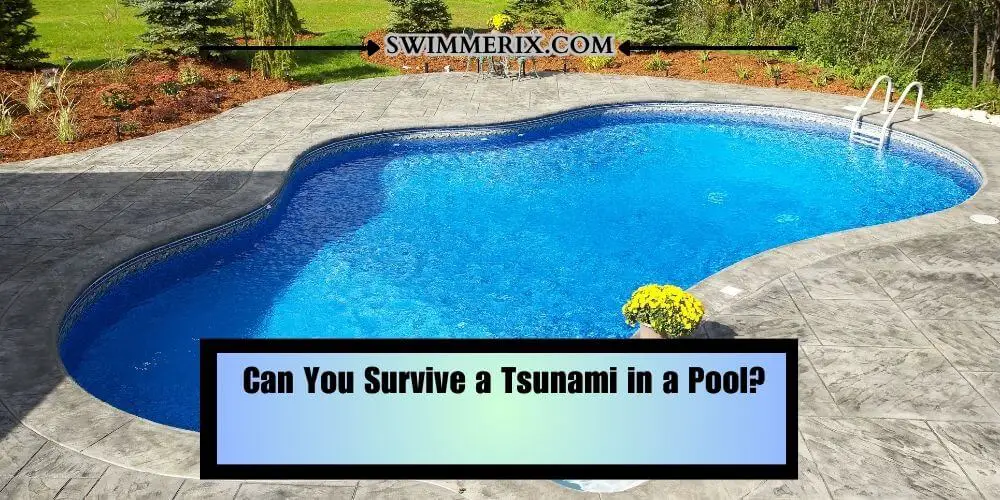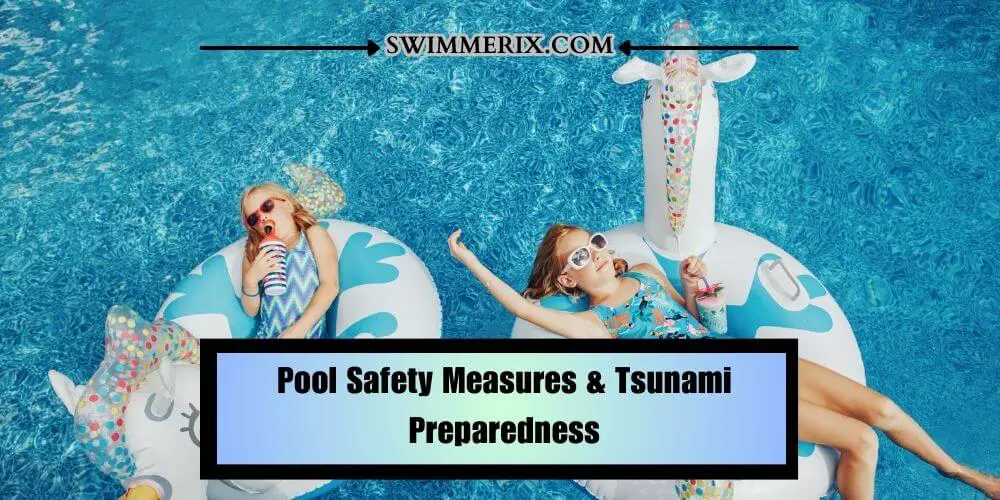
When swimming in the pool, a sudden thought pops into your head: could I survive a tsunami if it were to strike while I am in this pool? Well, this is a fascinating question that piques curiosity & raises concern.
Therefore, in this article, I will help you learn ‘Can you survive a Tsunami in a pool?’ and explore the power of these destructive forces of nature. We will further discuss whether the pool can provide sufficient protection from the damage caused by tsunamis.
Therefore if you want to ride the waves of knowledge and discover the truth about surviving in a pool, stay with this article. First, Let’s understand ‘Can you survive a tsunami in a pool.’
Can You Survive a Tsunami in a Pool?

No, you cannot survive in a pool during Tsunami. Pools are usually designed for recreation & leisure, not to withstand the force of Tsunami waves. Tsunami waves generate powerful & turbulent currents that can carry heavy debris ranging from trees & cars to massive chunks of buildings.
Also, you should note that the chaotic nature of the Tsunami, combined with the fear & panic it induces, can lead to poor decision-making & impulsive actions. To comprehend the potential danger of Tsunamis, you first need to understand what they are.
Tsunamis are gigantic Ocean waves usually caused by underwater earthquakes, volcanic eruptions, or landslides. Also, you should note that these waves can travel at incredible speeds, sometimes exceeding 500 miles per hour & can reach towering heights of over 100 feet.
Also, the Tsunami’s sheer power & energy make it one of our planet’s most devastating natural disasters. There are some comparable characteristics if you want to grasp the vast difference between regular pool waves and tsunami waves.
You should know that regular pool waves tend to be small, measuring a few feet in height and traveling leisurely.
On the other hand, Tsunami waves are known to be colossal monsters and can generate immense kinetic energy capable of demolishing buildings, trees, or anything else in their path.
Also, the force exerted by Tsunami waves is far beyond what a regular pool wave could ever muster. Therefore, before I tell you the potential survival strategies during this kind of catastrophic event, let’s first understand the limitations & risks of surviving a Tsunami in a pool.
3 Limitations and Risks
Before I tell you the potential survival strategies for Tsunamis, it is important to acknowledge the limitation and risks of seeking refuge in a pool during this disastrous natural event.
Limited Space & Depth In A Pool
Almost all types of pools are specially designed for recreation & leisure purposes, notwithstanding the force of Tsunami waves. Plus, they’re often relatively small & shallow, meaning they will offer you eliminated space for escape and inadequate protection against the overwhelming power of this Tsunami. Also, Loose Corners in Pool Liners can make the situation worse. Hence, It’s bad to seek refugees in a pool during a catastrophic event like Tsunami.
Potential Impact Of Debris Carried By Tsunami Waves
Also, you should know that tsunamis carry an incredible amount of debris, ranging from trees & cars to massive chunks of buildings.
Since pools are not designed to protect you from this kind of heavy debris, you shouldn’t think of them as shielding you from the danger posed by these. Flying debris can cause severe injuries as well as death in rare cases if you try to seek refuge in a pool during a Tsunami.
The Risk Of Being Trapped Underwater Due To Turbulent Currents.
If you have ever witnessed a Tsunami, you might know that the waves generate powerful & turbulent currents that can be extremely dangerous, especially in a confined space like a pool. This current type can trap you & other swimmers underwater, making it difficult to surface for air, further increasing the risk of drowning.
5 Potential Survival Strategies
Early Detection & Evacuation
You must detect a tsunami early and evacuate to a safe location in order to survive.
To ensure thorough preparedness, you should continuously heed tsunami warnings and adhere to the official instructions.
Many types of mobile apps, silencers, and other warning systems have a crucial role in providing timely information.
Additionally, it’s important to know that coastal areas often establish clear evacuation plans. Therefore, you need to acquaint yourself with these plans and be ready to take quick action.
Seeking Elevated Positions Within The Pool Area
If you fail to evacuate, I suggest you seek an elevated position within the pool areas. Also, it would help if you considered identifying any higher platform structures or nearby buildings that can offer you better protection against the force of Tsunami waves. Climbing to a higher ground level is very helpful in reducing exposure to the waves and increasing the chances of survival at full stop.
Using Flotation Devices
Conversely, if you find yourself trapped in a pool with a tsunami approaching, it’s advisable to utilize flotation devices to enhance your likelihood of remaining buoyant and greatly reduce the risk of submersion.
There are many types of flotation devices, including life jackets, pool floats, or any other buoyant objects that you can utilize to stay above the water & minimize the risk of being carried away by the waves.
Protecting Against Debris An Impacts
As I told you earlier, Tsunami powerful waves can carry heavy debris that can cause severe harm. Therefore, you should also identify any potential hazards within the pool area and take cover behind study objects to shield yourself from flying debris. Also, note that a table or a wall provides additional protection against impacts more than staying in the pool.
Maintaining Calm & Conserving Energy
If you happen to find yourself in this kind of crisis, the first thing you need to do is to remain calm. You should note that panic can cloud judgment and lead to poor decision-making. Rather, you should stay focused to think rationally & conserve your energy.
It would help if you didn’t make any unnecessary physical exertion that can tire you quickly, making it more challenging to survive & respond to the evolving situation.
Pool Safety Measures & Tsunami Preparedness

3 Pool Safety Measures
- Regular Maintenance & Inspections Of The Pool Structure: Being responsible pool owners, you should always prioritize regular maintenance & inspection to ensure the pool’s structural integrity. Therefore, you should always check for any signs of damage, leaks, or weak spots that may compromise your or the pool’s safety during an emergency.
- Proper Installation Of Pool Safety Equipment: Consider installing fences, alarms, and safety equipment & maintain them properly to established guidelines & regulations. These kinds of measures are very helpful in preventing accidents & ensure a safer environment for swimmers.
- Implementation Of Safety Rules & Swimming Guidelines: You must always establish and prominently display clear & concise safety rules in pool areas. Also, ensure that these rules cover all aspects, like appropriate behavior, diving restrictions, and emergency procedures, to promote a safer swimming environment.
Bonus: You must hire well-trained lifeguards and staff members to ensure the safety of swimmers. Ensure the employees know about emergency response procedures, including evacuation protocols specific to Tsunamis. Also, you must have them stay prepared for any crisis through regular training and drills.
4 Tsunami Preparedness
Educating Individuals About Tsunamis & Their Potential Dangers
It would help if you considered participating in raising public awareness about Tsunami & informing people about the risks involved through public education campaigns. It would help if you also considered disseminating educational material and covering topics like Tsunami warning signs, evacuation procedures, and self-protection measures.
Developing Tsunami Evacuation Plans For Pool Facilities Near Coastal Areas
If your pool facilities are located in coastal areas, you must have a well-defined Tsunami evacuation plan. If you don’t have one, consider factors like safety assembly points, routes to higher ground, and communication channels to coordinate evacuation effectively.
Conducting Regular Drills & Exercises To Ensure Preparedness
As I told you earlier, you should consider regular drills & exercises that help familiarise pool staff and visitors with the action they need to take during the event of a Tsunami. It would help if you simulated realistic scenarios & test the effectiveness of the evacuation plans.
Collaborating With Local Authorities & Emergency Response Teams
I also advise establishing a strong partnership with the local authorities & emergency response team. People must coordinate with these kinds of organizations to develop comprehensive disaster response strategies, ensuring a coordinated and efficient response during a Tsunami.
Conclusion
Even though pools can provide some protection in certain situations, it is never an ideal place to see refugees during a Tsunami. As I told you in the above section, the force & disrupting power of Tsunami waves fat exceed what a pool can withstand.
I have given my best to help you learn the importance of prioritizing early detection and preparedness to ensure personal safety and swimmers’ well-being during such catastrophic events.
It would help if you remembered that your safety is of utmost importance, so make sure to stay informed, follow official instructions, and be prepared to take necessary actions that can protect you & those around you.
I have given my best to give you proper in-depth knowledge of the question, ‘Can you survive a tsunami in a pool.’ If you find this article helpful, then consider sharing it. Your share will help many people learn the answer to the question, ‘Can you survive a tsunami in a pool.’ See you in the next post, till then, take care & goodbye.

Hi, This is Josh. I am a former competitive swimmer and current fitness enthusiast.
I created this site to share my love of swimming with the world!
